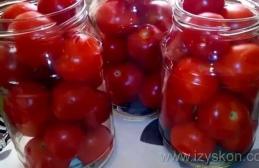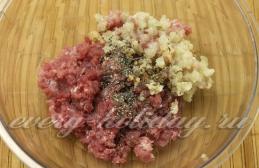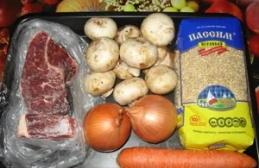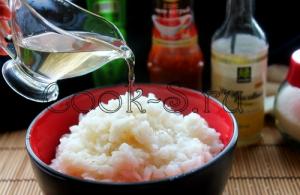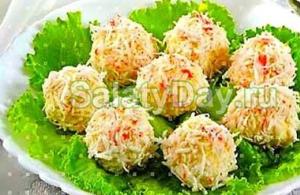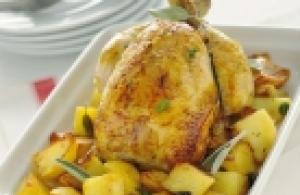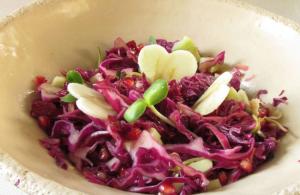It’s hard to call sushi fast food. After all, rolling rolls is a real art, which is carefully learned from masters. And among the Japanese, eating sushi turns into a complex and lengthy ceremony. And although the ingredients for rolls and sashimi are, in general, simple products (rice, fish, seafood, soy sauce), preparing these dishes is quite difficult. But it is possible, even at home. In this article we will not talk about how to spin rolls. Let's focus on just one stage of their production - we'll discuss how to make sushi rice at home. This is the basis of the dish. If you compare rolls to fine art, rice is a primer for a painting, onto which the artist must apply paint. Yes, of course, the taste of sushi is determined by fish or seafood. But if the rice in them looks like porridge from kindergarten, all the art of creating this dish will come to naught.
Japanese vinegar and noria: preparing rolls yourself
Sushi requires special equipment - at least a makis, for professional rolling of products. Exotic products will also be required. For example, nori is sheets of dried and compressed edible seaweed. Or wasabi - a special horseradish paste. Gari - thin sheets of pickled ginger - is also difficult to make at home. But you can create Japanese vinegar yourself. To do this, you need to dissolve two large spoons of sugar and one teaspoon of salt in a third of a cup of regular table (or apple) acidifier. We don't need very much Japanese vinegar. There are only two spoons for two glasses of rice. But it defines the basis of taste. Now let’s start preparing sushi rice at home. In this case, the recipes advise us not to show initiative, but to strictly adhere to the Japanese tradition. After all, it has been practiced for centuries.

What kind of rice is suitable for sushi?
As for cereals, they require special ones. Small and round grains containing a lot of gluten. In large supermarkets, special “Sushi Rice” is sold in special sections. At home, recipes suggest using Krasnodar or Crimean cereals. In appearance it resembles Japanese. Elite basmati is good for pilaf, but not for rolls. Sushi rolled from it will crumble. Also, there is no need to be clever and show imagination where this is not required: all sorts of steamed, brown, unpolished and wild varieties will not work. Also, masters of Japanese cuisine will reject rice in bags. Only round grains, polished and uncrushed, are suitable. If there is none, long-grain rice should be soaked in cold, preferably filtered, water for a couple of hours. Then rinse and set to cook.
Secrets of product replacement: how to turn Krasnodar rice into Japanese
The cereal, ripened in the flooded fields of the Land of the Rising Sun, is not only small and round, but also contains a large amount of gluten. It is thanks to her that the rolls keep their shape well. How to use for sushi at home? Recipes suggest that we rinse the cereal thoroughly. Pour two glasses into a sieve or fine colander and keep under running water until clean and clear water drains from the cereal. This way we will get rid of excess. Porridge for sushi should under no circumstances be crumbly. But an overly viscous and watery base will also not work. Therefore, the ratio of water and cereal when cooking porridge is the second very important condition for creating successful rolls.

How to cook sushi rice at home
The recipe asks us to pour cold water over the cereal. But if for pilaf or porridge we keep the proportions of one to two, then rolls require a different approach. There should be equal amounts of rice and water. The same amount of liquid should go into two glasses of cereal. “How will the porridge cook,” you ask, “will it burn?” The whole secret is how to prepare sushi rice at home. Recipes for creating pilaf, casseroles, babkas, baby porridges and rolls are very different. Rice is a universal cereal. It can be used to make a hard loaf-like bun, a pudding, or a viscous mixture. So, pour the washed rice with cold water and put it on the stove. It is best to take a saucepan with a thick bottom and not enameled. The ideal solution would be a small cauldron for pilaf. After the contents of the saucepan boil, cover it with a lid and cook for one minute over high heat. The time limit must be taken seriously - 60 seconds, no more and no less. Then the fire should be reduced. Do not remove the lid and cook the porridge for about fifteen to twenty minutes. As soon as we see that the liquid has completely evaporated, turn off the heat under the saucepan. Let stand covered for another ten minutes. This way we will get enough for sushi.

Recipe at home in a slow cooker
Many people doubt: can a machine make cereal for rolls? After all, Japanese chefs put their soul into every stage of preparing this incomparable dish. Let's cast aside all doubts. The multicooker not only copes with this task, but also creates the perfect rice for sushi. Cooking at home in a slow cooker will not take you much time. And the result will be even better than if you cooked the cereal in a pan. After all, you won’t need to open the lid, which means you won’t let steam out of the container, causing the rice to reach perfect stickiness. The only thing you should take care of is to rinse the cereal well. You need to pour a little more water - 2.5 measures of liquid for two glasses of grain. The multicooker bowl should be filled to no more than two-thirds of its volume. Set the “buckwheat” or “rice” mode. In machines of a different design, you can use the “Baking” program by setting the timer for ten minutes, and when the time is up, start the “Stewing” program for twenty minutes.

Authentic sauce
Even properly cooked cereal will remain a simple porridge if sauce is not added to it. An authentic Japanese sushi dressing includes mirin cooking wine (or sake vodka), special rice vinegar, sea salt and sugar. The base for the rolls gives a special charm. It is placed in the sauce when it is warmed up and later taken out. When combined, the dressing and rice should be approximately the same temperature - warm. Believe it or not, real masters cool the cereal with a fan so that it shines beautifully in the rolls. But on our agenda is sushi rice at home. Recipes, photos and useful tips teach us how to do without exotic ingredients and get a product that is as close to authentic as possible. So, let's prepare a sauce based on 250 grams of cereal.

What is rice vinegar
Although it is called Japanese, it was invented by the Chinese. According to some reports, this happened more than two thousand years ago. How was this vinegar prepared? The fish was cut into small pieces. Then they salted it and mixed it with rice. The enzymes released by the fish acted on the grain, and lactic acid was released. On the one hand, it preserved the fish, increasing its shelf life to a year, and on the other hand, it gave it a sour taste. In the fourth century AD, rice vinegar became famous in Japan. It was very expensive and was used only by the nobility. Vinegar became available to the common people only in the sixteenth century. Why are we providing all these details? To show that compared to other European sauces, rice sauce has the mildest taste. In addition, it is an excellent antibacterial agent. And if you take into account that in Japan raw fish is often served at the table, protecting yourself from various infections is very important. And most importantly, the sauce enhances the sushi rice. The recipe (following it at home is not a problem), which we will give below, assumes the presence of this vinegar. Getting it when the popularity of rolls around the world is growing is not so difficult. It is sold in the same stores as wasabi and nori seaweed.

Vinegar sauce
Well, let's season our sushi rice. The recipe at home is not much different from the one used in professional Japanese restaurants. The main thing is to have Mitsukan rice vinegar. It will require 180 milliliters. 120 grams of sugar and a spoonful of sea salt should be dissolved in this vinegar. It is also worth adding a small piece of kombu seaweed at the initial stage. After ten minutes it can be thrown away. Heat all the ingredients, but do not bring to a boil. Then cool, pour into a tightly sealed glass container and put in the refrigerator. That is, the sauce can be prepared for future use. But if you want to use a small amount for already cooked rice, cool the sauce to the temperature of the grain. Pour in a small amount of mirin or sake. If you don’t have Japanese alcohol on hand, don’t worry, we’ll skip this stage of preparation. Place the rice in a wide bowl. Pour over the sauce. Use a wooden spatula to carefully turn the rice over, but do not stir it (otherwise it will turn out to be porridge). Cool to room temperature. That's it, you can spin the rolls.
Rice Vinegar Alternative
All European types of acidulants have a more pronounced taste, so they need to be added in small quantities. There are several ways to prepare the dressing to pour over sushi rice. A recipe (at home) with apple cider vinegar is one of them. Mix a tablespoon of acidifier with a teaspoon of sugar and a pinch of iodized salt. Add one and a half tablespoons of hot water to this solution. Stir until the crystals disappear completely. Pour this sauce over the rice.
It may seem only at first glance that cooking rice for rolls is a simple procedure. However, experts say that this is not true at all! Here you will see a photo recipe, as well as a detailed video at the end of the article.
At home
Firstly, it is immediately necessary to warn the cook who is taking up “Japanese cuisine” for the first time. You will need: wooden spatula for stirring rice And wooden bowl for drying it. Also preferred Instead of regular table salt, use sea salt, but take sugar, it’s healthy. We also need rice vinegar, however, if we don’t have it, we can replace it with wine vinegar. But the question of what kind of rice should I buy for rolls?, you need to pay special attention.
Precisely because Are you choosing the right type of rice?, the result of your work depends. The best option would be to use Sushi Meshi rice for this dish. This is the same rice from which real Japanese prepare real rolls. You can also purchase “Koshi-Hakari” or “Sushiki” for these purposes. These varieties are definitely suitable for any dishes of both Japanese and Chinese cuisine. At worst, you can take any other round-grain rice. The shape of the cereal grains should be round and about 5 millimeters in length. Of course, this should be done not at all from an aesthetic point of view, but for the simple reason that round rice is more prone to grains sticking together during cooking, which is exactly what we need.
The first step in preparing rice for rolls is to rinse it with cold water for a long time. Here it is necessary to achieve transparency of the water drained from the rice. It should not only cleanse the cereal of contaminants, but also wash off all excess starch from it. So, don’t be afraid to rinse the rice an extra time—this will only make the dish better! So, wash the rice, changing the water at least 10 times.

You can use either regular pans or a double boiler to cook rice directly. Moreover, the model of the steamer does not have any influence on the quality of the prepared dish. If you are going to cook rice in the traditional way using a pan, then choose an enamel or stainless steel pan. Another important aspect when cooking is that the lid of the saucepan must fit tightly to it.
After washing the rice, it is left to lie for forty to forty-five minutes without water, so to speak, to “rest.” During this time, the moisture that remains on the grains after washing will be absorbed into the rice, and the rice itself will swell slightly. Some cooking methods recommend soaking the rice in water for 10 minutes. Later, you can try different cooking methods to find the best one.

Pour 1 portion of washed rice into the pan and pour ¼ of this portion of water. A unique aroma comes from a sheet of nori seaweed placed briefly in water with boiling rice. But after the water boils, the algae must be removed. After boiling, cook the rice over medium heat for exactly ten minutes, after which we turn off the heat and wrap the pan in a towel for another ten minutes.

At this time, we are preparing a solution that we will need to add to the cooked rice. It consists of rice vinegar, sugar and salt. We repeat, rice vinegar can be replaced with wine vinegar, but it is better to use sea salt, just as sugar should not be ordinary, but cane. Dissolve salt and sugar in a bowl, adding vinegar. The calculation of the required amount is approximately this: for 180 grams of dry rice you need a tablespoon of vinegar, a teaspoon of sugar and half a teaspoon of salt. This solution should be poured over cooked rice.
And now we need a wooden spatula and a wooden bowl. Having placed the rice on a plate, we should mix it thoroughly with a wooden spatula and leave it to dry. It needs to be given time to absorb the vinegar brine.
Answer the question in more detail: ? will help video located below:
Well, if you carefully read the recipe for preparing rice for rolls and carefully followed all the instructions, then everything should turn out no worse than in the most luxurious sushi bars!
In the modern world, Japanese cuisine has become incredibly popular, and it is quite difficult to imagine a person who has never tasted rolls or sushi. Healthy, beautiful and incredibly tasty dishes from the Land of the Rising Sun are liked by many, including in Russia.
Visitors to cafes and restaurants love to enjoy this cuisine. But sometimes circumstances are such that there is no desire or money to go to a restaurant, but you really want to eat rolls. This is where this article will come to the rescue. We will review and tell you everything about cooking Japanese cuisine at home. After reading this article, you will learn how to professionally prepare sushi and rolls no worse than in expensive restaurants, and you will also learn several interesting recipes.
Before you start, you should also pay attention to the fact that rolls and sushi are far from the same thing. Very often these dishes are confused with each other and for good reason - they are really extremely similar.
Sushi is a traditional Japanese dish made from rice with a special vinegar sauce and various seafood. For example, nigirizushi and gunkan-maki are examples of hand-made sushi.
Rolls- this is just one of the popular varieties of sushi, the peculiarity of which is the rolling of the product using bamboo into a cylindrical shape and cutting into pieces (slices), most often into 6 or 8, but sometimes more. The filling, along with rice, is wrapped in special pressed seaweed - a sheet of nori. There are a huge number of different varieties of rolls, for example, some of the most famous are “Philadelphia”, “California”, as well as traditional rolls and “Unagi”.
How to properly cook rice for rolls
Let's start with, perhaps, the most important element of Asian cuisine - this is rice. It is important not only to choose this food product correctly, but also to cook it correctly. This is an extremely important component, on which the appearance, sophistication and taste of the final dish largely depend. Rice is good because it goes well with almost any seafood, like fish, caviar, shrimp or even squid or octopus. Also keep in mind that the consistency and taste of rice prepared specifically for rolls differs from the typical one found in Russian cuisine.
Incorrectly cooked or simply unsuitable rice will fall apart, and the dish itself will have a somewhat unappetizing, unattractive appearance. To avoid all this, it is important to know how to choose and prepare the product correctly.
How to cook rice for rolls Recipe No. 1
The first thing you need to do is decide what kind of rice to buy. In fact, it is not at all necessary to overpay for an expensive product labeled “Japanese” or “specially for sushi.” Regular round grain rice, sold in any store at a relatively inexpensive price, is also suitable. The main thing is not to use parboiled or long grain rice. And wild, black rice is also not suitable for making sushi or rolls.
The main characteristic when choosing this nutritious crop is it's high stickiness. In addition, the cereal should not be crumbly. Ideally, if everything is done exactly according to the traditional Japanese recipe, then there should also be no rice husk, the rice grains should be the same size and should not be broken, and the rice itself should have a uniform, opaque, pearly white color. The ideal varieties of rice for Chinese and Japanese dishes are Sushiki and Koshi-Higari. But if we want to save a little, it will be enough to simply rinse regular round grain rice more thoroughly (at least seven times).

Having made your choice, you can start cooking:
- Rinse the rice thoroughly under cold water until the liquid in the saucer is clear and completely clean. Some people advise leaving the rice for about half an hour to dry after washing.
- We put our snow-white cereals in a pre-prepared pan. Pour water into it in such an amount that in the end there will be one and a half times more water than the rice itself and put it on fire.
- Do not add salt or add any spices!
- When the water boils, tightly cover the pan with rice and select low heat. It is also important that the rice does not burn; however, under no circumstances should you open the lid and stir the cereal during the cooking process, as otherwise the rice will taste harsh due to heat loss. Therefore, it is advisable to immediately choose the right, suitable large saucepan with a thick bottom.
- It is necessary to cook for about 10–15 minutes until the moisture has completely evaporated, but no longer than 20 minutes. Otherwise, there is a high risk that the rice will be overcooked and stick to the bottom of the pan. Do not forget that you should never stir the product or open the lid ahead of time if you want to do everything according to the recipe and end up with properly cooked cereal.
- After removing from the heat, continue steaming the cooked rice under a tightly closed lid for about another 10 minutes. Then transfer it to a previously prepared container.
- While the rice has not yet cooled, pour it with a special, pre-prepared dressing made from rice vinegar, salt and sugar. (The recipe, as well as information on how to prepare this dressing, will follow). If you don’t want to prepare this dressing yourself, you can always buy it ready-made in the sushi section of your store. Typically, this dressing is called “sushi sauce.”
- Stir, preferably with a wooden spatula, the rice and sauce.
- Cool the resulting rice grains to room temperature and you can start making rolls. Keep in mind - in no case should you put freshly cooked rice for Japanese and Chinese dishes in the refrigerator or leave it for a long time, for example, a day, as then the rice will become hard and the final taste will deteriorate greatly.
How to make your own special sauce for sushi
Dressing for rice It’s quite easy to do it yourself without much effort. It will be enough to buy rice vinegar, salt and sugar. Please pay special attention to the fact that ordinary vinegar will not work here in any case; it is rice vinegar that is needed. So, recipe as simple as possible:
- For half a kilogram of finished cereal, you need to take about two tablespoons of rice vinegar, one teaspoon of salt and one teaspoon of sugar.
- Mix the rice vinegar, sugar and salt together and heat the mixture until completely dissolved, stirring occasionally over medium heat.
- Some chefs also recommend adding nori or kim in addition to sugar, vinegar and salt. This is a type of edible algae from Asian countries. Nori is a Japanese type and has a sweet, classic roll flavor, while kim is a Korean type. It tastes saltier. However, keep in mind that if you add this seaweed to the dressing, you do not need to add it to the rice when cooking. Pick one thing.
- The sauce is ready, cool it slightly and you can pour it over your rice for sushi or rolls. It is important that the rice itself is still hot during the mixing process.
- Afterwards, the seasoned rice, according to Japanese traditions, was cooled using a special fan. It is believed that this gives it a special pearl shine. The product should cool down enough so that your hands do not get hot during the process of forming sushi or rolls. It is also recommended to periodically wet your hands in water with the addition of rice vinegar.
How to cook rice for rolls Recipe No. 2
There is also a slightly simpler method of preparing rice for Asian dishes. This is the rice recipe using a multicooker. It can make your work in the kitchen much easier and save you some time. So, you will need:
- sugar;
- vegetable oil;
- 100 grams of rice;
- 0.2 liters of water.
Having taken everything we need, we begin to prepare:
- Rinse the cereal thoroughly with cold water and then place it in a multicooker cup.
- Pour water into the slow cooker with rice. Keep in mind that the liquid needed is one and a half times more than the culture itself.
- Add one teaspoon of sugar and about the same amount of vegetable oil.
- Select the same mode as if you were currently cooking buckwheat. In some multicookers, this mode is directly labeled - “Buckwheat” or “Rice”. If you don’t have such modes, then set the “Baking” mode for about 10 minutes, and then change it to the “Stew” mode for another 20 minutes.
- Then turn off the device and let the rice sit for about 10-15 minutes without opening the tightly closed lid.
- Add sushi sauce and let the dish cool slightly. All is ready!
Recipe for making delicious rolls at home
So, we have prepared and absolutely correctly cooked special rice for sushi and rolls ourselves, made a special dressing for it from rice vinegar, sugar and salt, but what to do with all this next? Let's look at a simple recipe for making salmon rolls at home. Naturally, instead of salmon, you can use any other ingredient that suits you, for example, salmon or even regular cucumber. It all depends on your imagination and capabilities. The recipes will not be much different unless you want to make some other type of rolls other than traditional ones.
We will need the following ingredients:
- bamboo mat or makisa (mat for forming rolls);
- one glass of rice for rolls;
- one and a half glasses of water;
- approximately 200 grams of salmon or salmon;
- several pieces of nori sheets or kim seaweed;
- sushi sauce (dressing made from rice vinegar, salt and sugar) - about 50 ml;
- wasabi (not for everyone)
Recipe:
- Place a portion of warm, pre-cooked rice for rolls on a sheet of nori. We distribute the cereal in a fairly thin layer, leaving space at the bottom and top edges of the sheet.
- Lubricate the rice with one drop of wasabi and place the fish fillet on it, not forgetting to remove the skin and bones in advance. The fish fillet must be cut into strips.
- We begin to carefully roll the resulting long roll into a tube, lifting the mat by the edge. To make it easier to fix the roll, one of the edges of the nori can be slightly moistened with water.
- After the roll is twisted and takes on the appearance of a kind of roll, we begin to divide it into slices using a sharp knife. The result should be six or eight even pieces.
- The dish is ready! Soy sauce, ginger and wasabi are considered ideal additions to rolls and sushi. Bon appetit!

Conclusion
Keep in mind that sushi, like rolls, is a perishable food. Since they often consist of seafood, eating sushi that has been stored for a long time can lead to diseases of the gastrointestinal tract. In fact, these Asian dishes are best consumed immediately after preparation and stored for no more than a few hours.
When choosing ingredients for your dishes, always use fresh ingredients, especially in the case of seafood such as fish. Research conducted by nutritionists shows that daily consumption of sushi can negatively affect human health. For example, nori contains a large amount of iodine and, if eaten daily, can have a harmful effect on the thyroid gland.
Always check the expiration date of the ingredients you buy. for your culinary experiments and buy fish only in trusted places! Prepare the rolls correctly, do not overdo it with their consumption and then they will, on the contrary, have a beneficial effect on the body, not to mention their amazing taste when prepared correctly.
Video
From our video you will learn how to prepare the right rice for making rolls or sushi.
Measure the rice and pour into the pan.
Be sure to rinse the rice 3-4 times with running water, which should be clear at the last rinse. Pour the rice into a thick-bottomed saucepan and add 275 ml of cold water.
Place the saucepan with the lid closed over medium heat and bring to a boil without opening the lid. Then reduce the heat to minimum and also, without opening the lid, cook the rice for exactly 15 minutes. After this, remove the lid, cover the pan with a clean towel and close the lid again (as in the photo). Leave the rice in this position for 15 minutes.
Stir the sushi dressing until the sugar and salt are completely dissolved.
Next, pour the dressing over the hot rice, stir it with a spoon, starting from the sides of the pan and continuing towards the middle - this way the dressing will be distributed completely throughout the rice and the rice grains will not be damaged.
Allow properly prepared sushi rice to cool and you can use it. The rice grains remain intact. The rice is perfectly molded and laid out on a sheet of nori, and it turns out very tasty.
Many people wonder: “ How to cook sushi rice?" Any person who has tried to make sushi with their own hands at home knows very well that a very important component of this dish is properly cooked rice. Cooking it requires a lot of effort and knowledge, since cooking in the usual way will not work here. In addition, to prepare sushi, it is better to purchase a special variety of rice designed specifically for this purpose. It is easier to work with than regular rice and costs a little more since it is a high quality rice.
How to choose rice?
To make your rolls tasty and look like real Japanese sushi, you should choose the right rice. The outcome of your choice will be the success of making sushi at home.
When going to the store to buy rice, we recommend choosing coarse-grain rice. It is used in most methods of preparing rolls. The point is in its special structure: after cooking, this rice sticks together better, which is an indispensable property in the process of preparing delicious homemade rolls.
In some stores you can see special Japanese rice intended specifically for sushi. It costs much more than other types of rice, but, as many lovers of Japanese cuisine say, it is practically no different from coarse-grain rice, so there is no point in overpaying once again just for packaging.
Once you have successfully selected the rice, you can consider the task 40% complete. The rest of the matter is to cook it correctly. Let's look at a few recipes with which you can do this at home.
How to cook in a saucepan on the stove?
To cook sushi rice at home in a saucepan, you will also need rice vinegar, with which you can achieve the desired density of the rice. Below we will describe several of the most popular methods, following which you can easily prepare excellent rice for homemade sushi using a stove and a pan.
- Place the rice in a bowl and add clean water. Rinse it thoroughly and change the water regularly until it stays as clean as you rinse. This is a very important step, try to take it responsibly, otherwise poorly washed rice can cause poorly prepared rolls. Now find a convenient container and pour rice into it. Then fill it all with water so that it covers all the rice. After this, you should cover the pan and place it on the stove, waiting for the water to boil. When this happens, turn the heat down and cook the rice until all the water has evaporated. If you see that there is no longer any water in the pan, then you should remove the rice from the oven and let it stand for another ten minutes. While the rice is steeping, take a mug and mix in it special rice vinegar, 3.5 tsp. sugar and 2 tsp. sea salt. When the bulk ingredients dissolve, pour this solution into the cereal, which must be transferred to a wet container in advance. Using a wooden spatula, gently stir the mixture with the rice by turning it over in the container, and then you can start preparing the sushi.
- Half an hour before cooking, rinse the rice thoroughly so that the water with which you wash it becomes clean. Then transfer the rice into a convenient container, fill it with water so that it slightly covers the rice, and then send the container to the fire. When boiling, the heat should be reduced, and then cook the rice as long as necessary until all the water has evaporated. Now remove the rice and let it sit for a while under the lid, and at this time make the rice sauce. To do this you will need to mix 7 tbsp. l. rice vinegar, 1 tbsp. l. salt, 3 tbsp. l. Sahara. Then transfer the rice into a bowl moistened with vinegar and use a special spatula to mix it with the resulting mixture. When the rice has cooled to room temperature, it will be ready to eat.
- Here we perform the same actions as in the first two methods: wash the rice, boil water, cook the rice, remove it and let it brew. Only now we need to prepare a slightly different dressing. To do this, you need to mix sugar, salt, vinegar and lemon juice in a small convenient container, then put it on the stove and bring to a boil. Cool the resulting mixture, pour it over the cooled rice and stir.

Cooking rice in a slow cooker and steamer
If you need to cook rice at home using a multicooker, then you will need the following set of ingredients: two glasses of rice, two and a half glasses of regular running water, rice vinegar, soy sauce, lemon juice, salt and sugar.
Before cooking, thoroughly rinse the rice, then pour it into the multicooker bowl, fill it with water and turn on the “Grains” mode. We wait half an hour, and at this time we mix all the other products to get vinegar, which you need to moisten the rice with.
After the sound signal, you need to pour the resulting mixture over the rice, stir it right in the multicooker, and then put it on a damp dish and start preparing sushi.
You can cook rice in a double boiler using the following method:: First, the rice must be washed at least six times, then pour it with water at room temperature for half an hour. After this, you can drain the water and pour the rice into the steamer bowl. Add the necessary spices, then set the timer to 35 minutes. After the specified time, the sushi rice will be ready for further manipulation.
Using a Rice Cooker
To cook the right sushi rice in a rice cooker, you first need to rinse it thoroughly. After that, pour the rice into a measuring cup and measure out the required amount. It should be borne in mind that during the cooking process the rice will swell and begin to take up much more space. This should guide you when choosing the optimal amount of rice.
Having measured out the required amount of rice, you need to soak it for a few minutes in water at room temperature, after which you can pour it into the bowl of the rice cooker. Next, fill it with water, add the necessary spices as desired, and collect the rice from the walls of the rice cooker. Make sure the water covers it completely, then you can turn on the rice cooker and cook the rice. After the beep, let the rice sit under the lid for about 15 minutes. After this it will be ready to eat.




